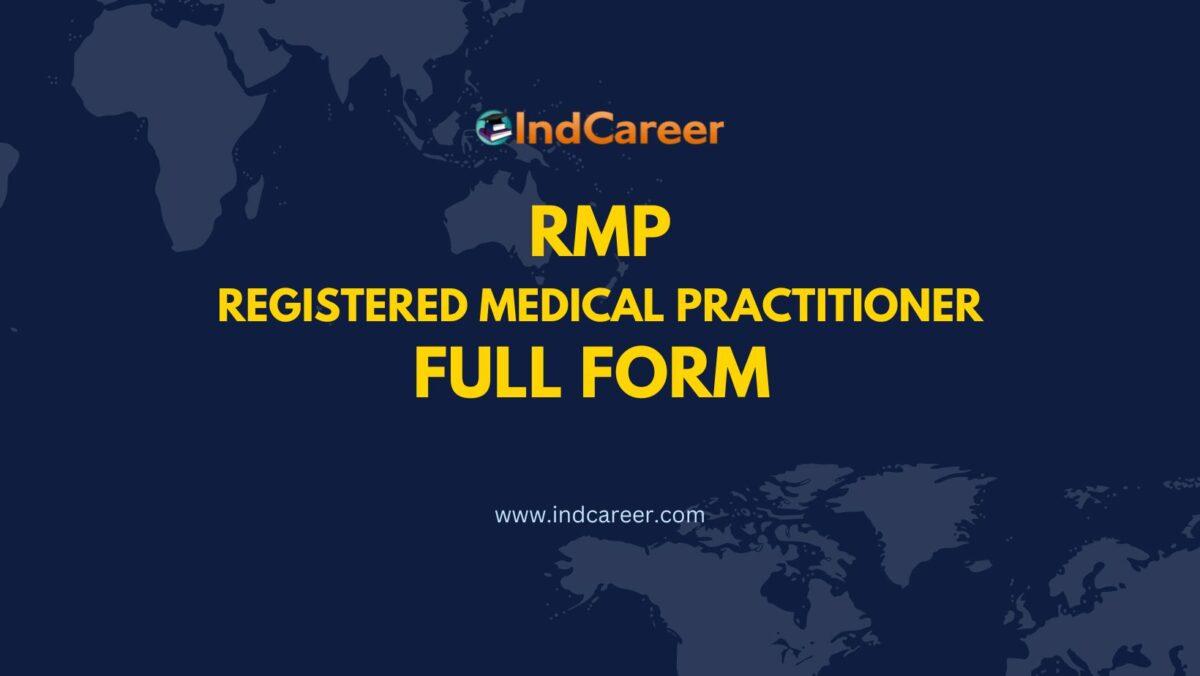Contents
In the world of healthcare, numerous medical professionals play essential roles in ensuring the well-being of patients. One such profession is that of the RMP. If you’ve ever wondered what RMP stands for and what their responsibilities are, you’ve come to the right place. In this article, we’ll explore the Full Form of RMP, their significance, and their role in the healthcare industry.
What is RMP?
Definition of RMP
RMP stands for “Registered Medical Practitioner.” An RMP is a qualified healthcare professional who has completed the necessary education, training, and licensure to diagnose and treat various medical conditions. These professionals act as the first point of contact for patients seeking medical attention.
Purpose of RMP
The primary purpose of an RMP is to provide accessible and immediate healthcare services to patients. They act as a bridge between patients and specialized medical practitioners, ensuring that individuals receive timely medical attention and appropriate treatment.
Understanding the Full Form of RMP
The Full Form of RMP, as mentioned earlier, is “Registered Medical Practitioner.” The term “registered” signifies that these medical practitioners are officially recognized and authorized by the relevant medical governing bodies to practice medicine.
Roles and Responsibilities of an RMP
Healthcare Services
RMPs are responsible for delivering comprehensive healthcare services to their patients. They conduct medical examinations, diagnose illnesses, and develop treatment plans to address various health issues.
Medication Management
Another crucial responsibility of RMPs is medication management. They prescribe medications, ensure proper dosage, and monitor the patient’s response to the treatment.
Patient Education
RMPs play a vital role in educating patients about their medical conditions and treatment options. They empower patients to make informed decisions about their health.
Record Keeping
Maintaining accurate medical records is essential for patient care and legal purposes. RMPs are responsible for maintaining detailed and up-to-date medical records of their patients.
How to Become an RMP?
Educational Requirements
To become an RMP, one must complete a bachelor’s degree in medicine (MBBS) from a recognized medical college or university. This is followed by a compulsory internship and practical training.
Licensure and Certification
After completing the educational requirements, aspiring RMPs must obtain a license from the appropriate medical regulatory authority to practice legally. Additionally, some countries or states may require additional certifications.
RMP vs. Other Medical Professionals
RMP vs. MD
The term “MD” stands for “Doctor of Medicine.” While both RMPs and MDs are qualified medical practitioners, the primary difference lies in their educational paths. MDs typically undergo more specialized training in specific medical fields.
RMP vs. DO
DO stands for “Doctor of Osteopathic Medicine.” RMPs and DOs share similar roles in primary healthcare. However, DOs also focus on osteopathic manipulative treatment (OMT) in addition to traditional medical practices.
Importance of RMPs in Healthcare
Primary Care Providers
RMPs serve as primary care providers, offering a wide range of medical services to patients of all ages. They are often the first point of contact in healthcare, providing essential medical assistance and referrals when necessary.
Accessibility to Healthcare
In many regions, especially in rural areas, access to specialized medical care is limited. RMPs play a crucial role in bridging this gap by providing immediate medical attention and necessary treatments.
Role in Rural Areas
RMPs are especially valuable in rural and remote areas where access to medical facilities is scarce. They are often the lifeline of healthcare in these regions, providing essential medical services to underserved communities.
Challenges Faced by RMPs
Limited Resources
In certain areas, RMPs may face challenges due to limited resources, including medical facilities, diagnostic equipment, and access to specialized care.
Multitasking Demands
RMPs often find themselves multitasking, managing a diverse range of patients and medical conditions simultaneously.
Legal and Ethical Concerns
Medical practice involves complex legal and ethical considerations. RMPs must navigate these challenges while ensuring the best care for their patients.
Future of RMPs
The future of RMPs is promising as they continue to play a vital role in the healthcare system, especially in addressing the primary care needs of patients. With advancements in telemedicine and technology, RMPs can reach even more people in need of medical attention.
Conclusion
In conclusion, RMP stands for “Registered Medical Practitioner.” These healthcare professionals serve as essential primary care providers, offering immediate medical attention and treatment to patients. They play a significant role in ensuring that healthcare is accessible to all, especially in remote and underserved areas. RMPs face challenges but remain dedicated to delivering the best possible care to their patients.
FAQs
RMP stands for “Registered Medical Practitioner.”
The responsibilities of an RMP include providing healthcare services, medication management, patient education, and maintaining medical records.
To become an RMP, one must complete a bachelor’s degree in medicine (MBBS) and obtain the necessary license and certifications.
While both are qualified medical practitioners, MDs undergo more specialized training in specific medical fields.
RMPs are crucial in providing accessible and immediate healthcare services, especially in underserved areas and as primary care providers.
